Rozett’s Nursery: An Island of Garden Wisdom
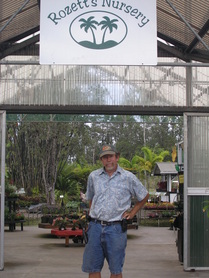
One such island can be found at Rozett’s Nursery. John Rozett isn’t your average nursery man. When he discusses the natural world, as you might expect, the subjects of botany and biology arise. What is surprising is that John engages with the natural world through art, culture, history and his own sense of spirituality that he has gleaned from many years living and working with the natural world in Hawaii. On entering Rozett’s nursery you encounter bright stripes of color, plants ready to grace Hawaiian gardens of all kinds. But step into the center courtyard beyond and Rozett’s becomes a destination, a place of reflection. It is the creation of a mind that creates meaning through a text of plants, rocks, textures and smells. Exotic bamboos soar among spreading palms, a forest oasis surrounded by and integrated with elderly ohia sentinels, in deference to ancient spirits.
After spending two semesters at the University of Oregon in the landscape architecture greenhouse, teaching lab classes on plants for interiors, John became intrigued with exotic tropical plants, which led him directly to Hilo on the Big Island in 1976. “I took a taxi from the airport to Uncle Billy’s and I had my bicycle as part of my luggage. I rode around old Hilo neighborhoods and was looking at Crotons that were 10’ tall that I had grown in 6” pots in Oregon and was just amazed at the vibrancy.”
While part of the agriculture program at U.H. Hilo, over the next few years John studied landscape architecture and worked for Bishop Museum for two years as an ethno botanist. He also worked in the greenhouse trade business and in field stock tree moving ventures. During his time with the Bishop Museum, John was involved with creating the Amy Greenwell Botanical Garden, which was his first solo design project. In order to do this, an archeological survey needed to be conducted. This put John in touch with native agricultural practices, as well as with Herb Kane, who was living on the Greenwell property at the time. His afternoon conversations with Herb deepened his understanding of Native Hawaiian practices and culture. He also came into contact with kupuna who were willing to share their knowledge with him, which touched him deeply.
These experiences gave him a rich tapestry of resources from which to draw. “So all these things are pieces of a big puzzle. I like design. I work with people on design all the time.” Rather than doing the design himself though, John prefers to engage people in a kind of Socratic process. “Most of the time I’m working with them on turning them into their own designer. I personally believe that your home landscape should reflect your own personal aesthetics not mine… people come in and instead of giving them answers, I answer their questions with questions…. When people come in here looking for landscapes, I try to awaken the genius within them.”
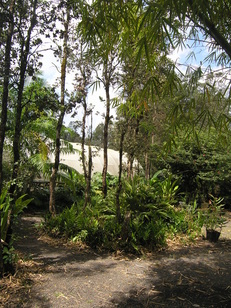
After purchasing the property in Pahoa in 1985 and with help of his wife, Donna, Rozett’s Nursery was born. His two sons, Ian and Colin, who grew up in the nursery, have become knowledgeable horticulturists and work along with John in the business. You can ask anyone who has had much to do with gardening or landscaping on this island and they will know John Rozett. John has been a source of boundless knowledge for island gardeners. He has conducted numerous workshops over the years and is always willing to share his knowledge with anyone who is in need of gardening and landscaping help. His is a knowledge that comes from deep connection with the ‘aina, a path he has followed to the heart of ancient Hawaiian wisdom. That wisdom is serving him well, as about five years ago John was diagnosed with Parkinson’s disease. It has progressed slowly so far and John has chosen to view it as a learning opportunity that will help focus his intent and understanding and has led him to decide that it is time to create a garden space that will be an intricate metaphor for all his experience, knowledge and wisdom.
This project is more visceral in exploring the roots of design motivation and "playing" with the parameters. It was a blank canvas and a concept that I allowed to simmer in the realm of abstract thought much longer than most designs are permitted to. As such, the evolution has remained fluid and the emergence of design enhancements has had almost a life of its own. Where I feel I'm being led to the design rather than inventing it. The plants, the boulders, the culturally divergent design philosophies I'm employing, as well as the site itself, are constantly "speaking" to me and influencing the flavor of the outcome.
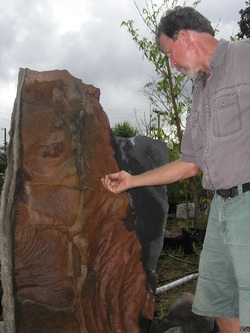
In a personally historic sense many of the plants in the garden have come to him as gifts and rescues. One of those rescues is the center of one of the many small islands that punctuate the garden. It features a large upright stone and a singular tree. Having fallen over, the tree was fitted with an upright bolder next to its exposed roots and covered with soil and rock slabs. The bolder, reminiscent of an Easter Island guardian, exhibits the artwork of natural forces and events that leave their stories engraved, waiting for discovery.
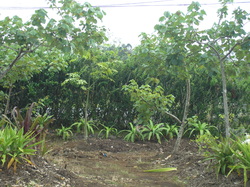
This theme is repeated in the overall design. Just as Polynesians sailing eastward to the outer reaches of the Pacific kingdom, the garden progresses from the West and the Asian-fusion area, eastwards to the Hawaiian shoreline garden. Standing next to the sacred bamboo, there is a pair of hala trees that stand as an invitation to what will eventually be an arbor quartet of hau trees forming a hau lanai, when they mature. Behind this is a row of Queen Emma Spider lilies that provides a shoreline feel and an Australian Flame Tree (Brachychidom acerifolium) whose leaves are a reference to papaya and kukui. There is nothing literal here as much as metaphorical whimsy.
John indulges human curiosity with features such as a line of rainbow shower plants along the fence. When they mature they will create a small mysterious path that leads through the back way behind the Bali sacred bamboo connecting to the Hawaiian shoreline garden. “This is my present to those who see a tracery of a path and say, ‘I've got to see where that goes’”.
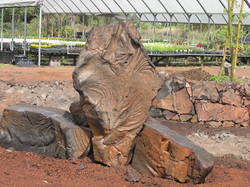
When John is finished with his garden “songline”, it will tell many stories of his experiences and understandings and embody, “ Art as part of day to day life; art as a communication tool in culture.” It will also provide a place where people can reflect on their own place within the natural context and perhaps to be inspired to create their own “songlines”. “It’s kind of like the corner lot here, the concept of world citizen rather than separatist. I view it from the point of view of the broader context. We’re all human. We all come from different backgrounds but we have a lot more in common. We have the opportunity to share and help each other grow by being open minded.” And isn’t that really the essence of ‘Aloha?
 RSS Feed
RSS Feed
